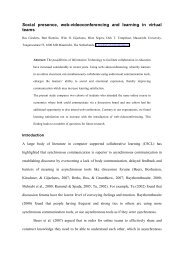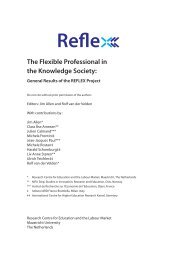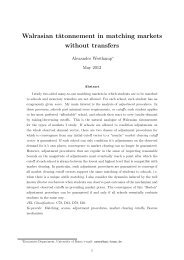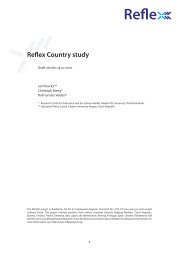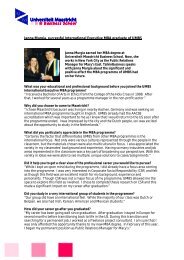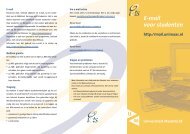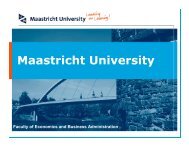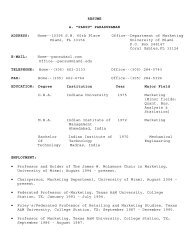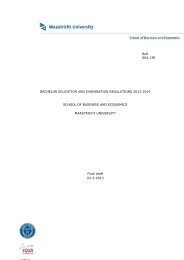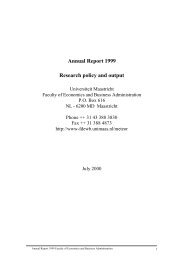proceedings of Student Mobility and ICT: Can E-LEARNING
proceedings of Student Mobility and ICT: Can E-LEARNING
proceedings of Student Mobility and ICT: Can E-LEARNING
You also want an ePaper? Increase the reach of your titles
YUMPU automatically turns print PDFs into web optimized ePapers that Google loves.
The implementation <strong>of</strong> online education <strong>and</strong> learning<br />
At a pragmatic level, there’s evidence <strong>of</strong> a substantive degree <strong>of</strong> consensus with repect to the<br />
adoption <strong>of</strong> particular pedagogic strategies in online learning, based on the perception <strong>of</strong> students as<br />
independent learners. By providing facilities for collaborative dialogue <strong>and</strong> task completion, with greater<br />
emphasis on small group work <strong>and</strong> exploratory learning, in other words, by ‘empowering the learner’,<br />
students are supported in their learning process. Tutor-student interactions, mentoring, promoting student<br />
dialogue <strong>and</strong> the design <strong>and</strong> evaluation <strong>of</strong> virtual seminars are examples <strong>of</strong> aming at better quality <strong>and</strong><br />
efficiency <strong>of</strong> online learning (Curran, 2001). Deb<strong>and</strong>e (2004) claims that four str<strong>and</strong>s must be integrated<br />
into a comprehensive policy: infrastructure <strong>and</strong> equipment, high-quality educational multimedia sevices<br />
<strong>and</strong> content, training services <strong>and</strong> facilities for teachers <strong>and</strong> for lifelong learning, <strong>and</strong> dialogue <strong>and</strong><br />
cooperation at all levels. Moreover, the implementation <strong>of</strong> a comprehensive online learning strategy should<br />
incorportate three stages: infrastructure, content <strong>and</strong> teacher training (Deb<strong>and</strong>e, 2004).<br />
Although research in remedial education in physical settings provide important factors for success<br />
(Kozeracki, 2002; McCabe & Day, 1998; Roueche & Roueche, 1999), based on literature <strong>and</strong> research<br />
concerning online education <strong>and</strong> the role <strong>of</strong> <strong>ICT</strong> in education, the following aspects are to be taken into<br />
consideration (Rienties, Dijkstra, Rehm, Tempelaar, & Blok, 2005a; Rienties, Rehm, & Dijkstra, 2005b;<br />
Rienties et al., 2006):<br />
• 24/7 online availability <strong>and</strong> accessibility: the use <strong>of</strong> the internet makes it possible for students<br />
to work or study wherever <strong>and</strong> whenever they want to (i.e. ubiquitous learning)<br />
• Adaptiveness: every student carries his personal luggage <strong>of</strong> (prior) knowlegde <strong>and</strong> has a<br />
unique learning style. Therefore every course should <strong>of</strong>fer an individual learning path, based<br />
on this prior knowledge, learning style <strong>and</strong> the preferences <strong>of</strong> the student. In other words, a<br />
course should adapt to the individual needs <strong>of</strong> the students<br />
• Interactivity: in an electronic learning environment, the communication between teachers <strong>and</strong><br />
students should be actively stimulated. Therefore there needs to be an intensive use <strong>of</strong> the<br />
communication <strong>and</strong> interaction methods in order to enhance the involvement, the learning<br />
pr<strong>of</strong>it <strong>and</strong> the active <strong>and</strong> authentic learning <strong>of</strong> the students<br />
• Responsiveness <strong>of</strong> feedback: feedback seems to play an important role in the interaction <strong>of</strong> an<br />
online course or programme. <strong>Student</strong>s seem to have an interest in quick <strong>and</strong> direct feedback<br />
on their performances. Furthermore, rapid feedback stimulates interaction in an online course<br />
• Flexible learning methods <strong>and</strong> assessment: the learning environment should not be hindered<br />
by the limitations <strong>of</strong> the technical, organisational <strong>and</strong> didactical organization <strong>of</strong> the electronic<br />
learning environment<br />
Brown <strong>and</strong> Bradley (2005) encourage a participatory design <strong>and</strong> implentation approach, where the<br />
e-learning system is a two-way street, allowing early <strong>and</strong> ongoing communications between designer <strong>and</strong><br />
users (Brown & Bradley, 2005). The authors suggest some additional elements at the heart <strong>of</strong> effective elearning<br />
design:<br />
• Activity: a rich activity refers to an activity that opens up opportunities for action rather than<br />
an activity that directs students down a prescribed pathway. It implies an active involvement<br />
<strong>of</strong> the learner in making choices about what experiences they will engage in. The action must<br />
be considered from the perspective <strong>of</strong> the actions <strong>and</strong> challenges it affords to the student<br />
• Scenario: besides activity, there needs to be a reason or motivation to undertake an<br />
educational activity if the learning has to be memorable <strong>and</strong> considered valuable. An<br />
interesting context or scenario can assist the activity to have meaning<br />
• Delivery: good educational design relies on appropriate delivery to reach its full potential<br />
• Context: not only the context in which the e-learning will be used is partially predictable for<br />
the design <strong>of</strong> the e-learning resources, the broader context to address the learning needs is<br />
relevant as well. Elements <strong>of</strong> activity, scenario <strong>and</strong> feedback need to take into account the<br />
users’ pr<strong>of</strong>iles <strong>and</strong> the delivery element needs to consider the technical infrastructure.<br />
However, additional contextual considerations include the institutional objectives <strong>of</strong> the e-<br />
Conference <strong>proceedings</strong> <strong>of</strong> <strong>Student</strong> <strong>Mobility</strong> <strong>and</strong> <strong>ICT</strong>: <strong>Can</strong> E-<strong>LEARNING</strong> overcome barriers <strong>of</strong> Life-Long learning?” 153




